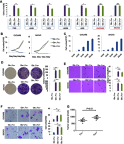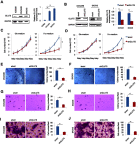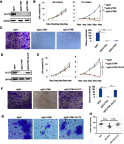GLUT5 increases fructose utilization in ovarian cancer
- PMID: 31371983
- PMCID: PMC6635899
- DOI: 10.2147/OTT.S205522
GLUT5 increases fructose utilization in ovarian cancer
Abstract
Background: Fructose is one of the most common dietary carbohydrates in the whole world, and recent studies have found that fructose consumption is closely related to the oncogenesis and development of tumors, however, very few studies have focused on the fructose in ovarian cancer. GLUT5 (Glucose transporter type 5), as a specific fructose transporter in mammalian cells, has also been found highly expressed in many cancers. Methods: In this study, we investigated the abilities of proliferation, colony formation, and migration of ovarian cancer cells in fructose medium, and then silenced GLUT5 in ovarian cancer cells to explore the role GLUT5 in fructose metabolism in ovarian cancer. Results: The results showed that the ovarian cancer cells had similar abilities of proliferation and migration in fructose medium and glucose medium, but silencing GLUT5 could significantly inhibit these abilities in fructose medium. Meanwhile, we found that GLUT5 was higher expressed in ovarian cancer tissues, and its expression correlated significantly with tumor malignancy and poor survival of ovarian cancer patients. Furthermore, the results of animal experiments also demonstrated that intake too much fructose could prominently increase tumor volume, and silencing GLUT5 could significantly inhibit tumor proliferation. Conclusion: In conclusion, we demonstrate that ovarian cancer cells could utilize fructose for their growth, and restricting the fructose intake or targeting GLUT5 may be efficacious strategies for ovarian cancer therapy.
Keywords: GLUT5; fructose; ovarian cancer.
Conflict of interest statement
The authors report no conflicts of interest in this work.
Figures




Similar articles
-
Targeting fructose metabolism by glucose transporter 5 regulation in human cholangiocarcinoma.Genes Dis. 2021 Oct 2;9(6):1727-1741. doi: 10.1016/j.gendis.2021.09.002. eCollection 2022 Nov. Genes Dis. 2021. PMID: 36157482 Free PMC article.
-
GLUT5 increases fructose utilization and promotes tumor progression in glioma.Biochem Biophys Res Commun. 2018 Jun 2;500(2):462-469. doi: 10.1016/j.bbrc.2018.04.103. Epub 2018 Apr 19. Biochem Biophys Res Commun. 2018. PMID: 29660339
-
SLC2A5 promotes lung adenocarcinoma cell growth and metastasis by enhancing fructose utilization.Cell Death Discov. 2018 Feb 26;4:38. doi: 10.1038/s41420-018-0038-5. eCollection 2018 Dec. Cell Death Discov. 2018. PMID: 29531835 Free PMC article.
-
GLUT5: structure, functions, diseases and potential applications.Acta Biochim Biophys Sin (Shanghai). 2023 Oct 25;55(10):1519-1538. doi: 10.3724/abbs.2023158. Acta Biochim Biophys Sin (Shanghai). 2023. PMID: 37674366 Free PMC article. Review.
-
GLUT5 expression and fructose transport in human skeletal muscle.Adv Exp Med Biol. 1998;441:35-45. doi: 10.1007/978-1-4899-1928-1_4. Adv Exp Med Biol. 1998. PMID: 9781312 Review.
Cited by
-
Targeting fructose metabolism by glucose transporter 5 regulation in human cholangiocarcinoma.Genes Dis. 2021 Oct 2;9(6):1727-1741. doi: 10.1016/j.gendis.2021.09.002. eCollection 2022 Nov. Genes Dis. 2021. PMID: 36157482 Free PMC article.
-
Fructose Metabolism in Cancer: Molecular Mechanisms and Therapeutic Implications.Int J Med Sci. 2025 Jun 9;22(11):2852-2876. doi: 10.7150/ijms.108549. eCollection 2025. Int J Med Sci. 2025. PMID: 40520908 Free PMC article. Review.
-
Loss of the fructose transporter SLC2A5 inhibits cancer cell migration.Front Cell Dev Biol. 2022 Sep 30;10:896297. doi: 10.3389/fcell.2022.896297. eCollection 2022. Front Cell Dev Biol. 2022. PMID: 36268513 Free PMC article.
-
Uncovering the Links Between Dietary Sugar and Cancer: A Narrative Review Exploring the Impact of Dietary Sugar and Fasting on Cancer Risk and Prevention.Cureus. 2024 Aug 21;16(8):e67434. doi: 10.7759/cureus.67434. eCollection 2024 Aug. Cureus. 2024. PMID: 39310400 Free PMC article. Review.
-
Envisioning Glucose Transporters (GLUTs and SGLTs) as Novel Intervention against Cancer: Drug Discovery Perspective and Targeting Approach.Curr Drug Targets. 2025;26(2):109-131. doi: 10.2174/0113894501335877240926101134. Curr Drug Targets. 2025. PMID: 39377414 Review.
References
LinkOut - more resources
Full Text Sources

